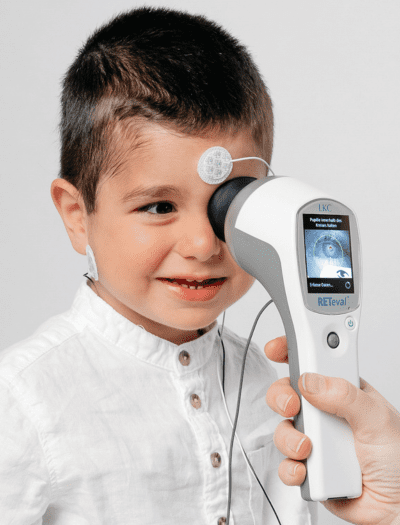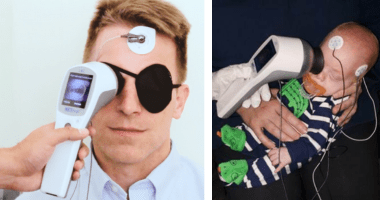Visual Evoked Potential (VEP) Explained
What is Visual Evoked Potential (VEP)?

How VEP works
A light stimulus provided by a computer monitor or ganzfeld bowl is received by the retinal cells of the eye. The electric potential travels from the retina to the visual cortex of the brain. Electrodes placed on the occipital lobe record the resulting electrical activity within the visual cortex.
What VEP tells us
Abnormalities in the VEP indicate potential distruptions in the visual pathway. VEP can help to detect the causitive mechanism of visual deficits.
- It is useful as a test of the visual pathway as a whole.
- Normal VEP indicates that visual information is successfully transmitted to the brain’s visual cortex for interpretation.
- Abnormalities may indicate issues with the transmission from the eye to the visual cortex.

VEP testing provides functional and objective data
VEP is a non-invasive measure of the electrophysiological responses of the brain to visual stimuli. VEP testing provides objective and recordable functional information even for non-cooperative, non-verbal, or unconscious patients.
Although imaging technology like MRI continues to advance, VEP is regarded as a valuable tool to help detect occult lesions within the visual pathway, and most especially within the optic nerve.

Why conduct VEP testings?
VEP is an objective test of visual function. Numerous syndromes and anomalies can affect the VEP, including optic neuritis, multiple sclerosis (MS), tumors, traumatic injuries, infections, and toxic agents. Interpretation of the VEP abnormalities can help differentiate between possible types of underlying pathologies.
Clinical Applications of VEP
VEP, as an aid in diagnosis and disease management, is clinically valuable to clinicians in the determination of neurological deficits causing vision issues — even when imaging is unreliable or inconclusive, or when symptoms appear to be subjective only. Likewise, VEP can be used to track functional recovery after an acquired or traumatic neurological event.[44]
VEP testing can therefore be used to assess:
- Misrouting in the optic nerve fibers (e.g. albinism)[43]
- Toxic or nutritional optic nerve dysfunctions[43]
- Optic neuritis suspects (resulting from demyelination e.g. multiple sclerosis)[42]
- Recovery from a range of optic pathway dysfunction[42]
- Cortical blindness due to meningitis or anoxia[42]
VEP testing can also be used to:
- Distinguish between inflammation and other optic neuropathies[42]
- Quantitatively ascertain visual system function and optic pathways due to head trauma[42]
- Help detect orbital tumors compressing the optic pathway[42]
- Monitor for potential optic nerve gliomas in patients with neurofibromatosis[42]
- Monitor cerebral function of patients in operating rooms or intensive care[44]
3 Types of VEP Tests
Different visual stimuli have been designed to produce different types of VEP results. In general, the clinically most used types of VEP testing are pattern-reversal VEP (PVEP or PRVEP), pattern-onset VEP, and flash VEP. Pattern-reversal stimulation is the gold standard for VEP testing, with the most consistent timing and waveform.[45] On the other hand, pattern-onset VEP and flash VEP are more commonly used for patients who cannot fixate such as infants.
